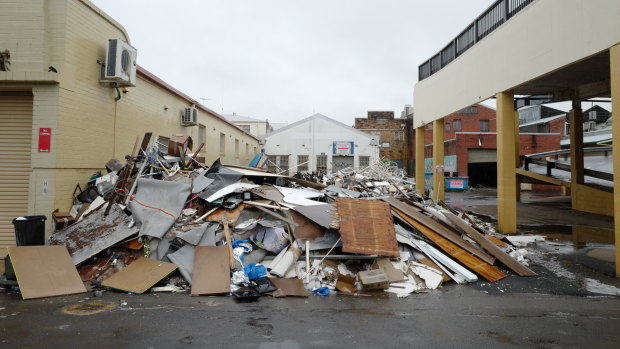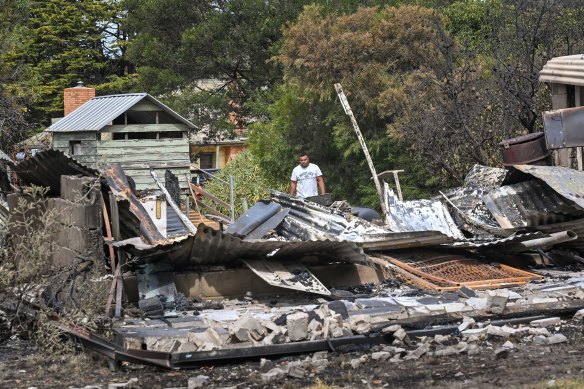Thirty per cent jump in households facing home insurance stress
By Shane Wright
Soaring home insurance premiums have left 1.6 million people in financial stress, increasing risks to the nation’s financial system as inflationary pressures and climate change make protecting the family home from disaster almost prohibitive.
A report from the Actuaries Institute, released on Monday, shows 360,000 more households, or an increase of 30 per cent over the past year, are spending at least a month’s gross income to cover their home insurance costs.

Debris outside businesses in the NSW town of Lismore following the 2022 floods.Credit: Getty Images
Fifteen per cent of households are under “home insurance affordability” stress, up from 12 per cent last year and well up on the 10 per cent who were in stress in 2022.
Insurances, from home to cars, have soared across the world since the end of the COVID-19 pandemic. In Australia, insurance has been one of the driving factors behind high inflation.
In Sydney, insurance prices have soared by 12.6 per cent over the past year and by 28.8 per cent over the past two years. Melbourne insurance prices have climbed by 11.1 per cent since June last year while Brisbane residents have endured a near 34 per cent lift in insurance prices over the past two years.
Sharanjit Paddam, lead author of the Actuaries Institute report, said affordability had gone backwards because of a median 9 per cent increase in home insurance premiums over the past year.
“While insurance remains generally affordable for 85 per cent of households, it’s concerning that there’s now 1.6 million households struggling to afford to insure their homes, up from 1.24 million a year ago,” he said.
“This is because increases in premiums are outpacing wages growth.”
The average home insurance premium in NSW is $2946, up almost $400 on last year, while in Victoria, the average premium is now at $2075.
The most expensive premiums are in the Northern Territory ($4186) and Queensland ($3815) while the lowest are in Tasmania ($1781) and the ACT ($1833). The ACT is the only part of the country that does not impose a stamp duty on insurance premiums.
The largest number of people in insurance stress are in south-west Queensland, NSW’s Northern Rivers region centred on Lismore, and regional Western Australia and the NT.
Half of households in these areas face premiums that exceed a month’s income due to their risk of flooding or cyclone damage.
The jump in the proportion of people in stress would have been worse but for an increase in wages.
When the institute started measuring insurance affordability in 2022, about 10 per cent of households were found to be in financial trouble.
‘This is potentially a problem that’s bigger than just insurance. It’s also a problem for lenders, regulators and governments.’
Sharanjit Paddam, author of the Aucuaries Institute report
Paddam said while there were several factors behind the increase in insurance premiums, climate change was a key one that would not go away.
He said people were already paying for the impact of climate change through higher premiums because of a lift in the number of climate-induced natural disasters.
“With 15 per cent of households already facing affordability stress for home insurance, climate change is a problem here and now,” he said.
Higher insurance premiums encourage people to either ditch their insurance altogether or under-insure their properties.
The institute estimates that 5 per cent or 180,000 households with a mortgage are in insurance affordability stress. The average premium for these properties, which represent $57 billion in home loans, is $5216.
Up to 16 per cent of home loans in NSW’s Northern Rivers are at risk because of affordability stress from insurance, while in parts of Queensland and WA, between 8 and 12 per cent are at risk.
Lenders in Australia require borrowers to have their home insured to qualify for a mortgage. While this is traditionally verified when a loan is first taken, most lenders do not check the insurance on an ongoing basis.
Paddam said there were growing financial risks where lenders did not enforce insurance requirements on their borrowers or if people failed to increase their insurance to take account of higher rebuilding costs.

Residents whose homes have been damaged by bushfires could be under financial stress if they are not insured.Credit: Justin McManus
“If their home is damaged by a natural disaster and they either don’t have insurance or are under-insured, they could find themselves in a stressful financial situation,” he said.
“This is potentially a problem that’s bigger than just insurance. It’s also a problem for lenders, regulators and governments.”
Cut through the noise of federal politics with news, views and expert analysis. Subscribers can sign up to our weekly Inside Politics newsletter.